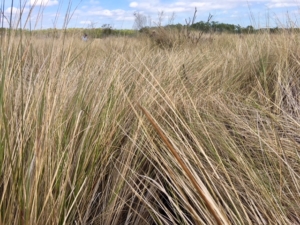Impoundment and High Marsh Mapping Projects Will Help Identify New Black Rail Habitat Opportunities
Black Rails require specific habitat conditions that include very shallow water and dense vegetation. These conditions are found in the highest and driest portion of the salt marsh (‘high marsh’) and in a variety of non-tidal wetlands, including managed impoundments. Knowing where to focus Black Rail conservation is the first step toward implementing actions on the ground. The ACJV worked with partners to initiate two major mapping projects in 2018; impoundment mapping in the South Atlantic and high marsh mapping in Florida. These products fill major spatial data gaps and together will result in ‘wall to wall’ coverage of impoundment and high marsh data throughout the ACJV area.
The ACJV thanks our summer intern, Amy Almond, for leading the impoundment mapping work. Amy spent the summer contacting National Wildlife Refuges and State agencies in Florida, Georgia, South Carolina and North Carolina, requesting spatial data, and delineating and describing managed impoundments. The response was tremendous and we now have a comprehensive map of 750 managed impoundments covering more than 120,000 acres of public lands in the southeast. Check out Amy’s story map describing her work.
In partnership with Old Dominion University and the South Atlantic Landscape Conservation Cooperative (SALCC), the ACJV is working to complete high marsh mapping work in Florida. High marsh mapping has already been completed by the SALCC for North Carolina, South Carolina and Georgia and by the Saltmarsh Habitat and Avian Research Program for Virginia north to Maine. The mapping work in Florida will complete coverage for the entire Atlantic and Florida Gulf Coasts. For more information go to https://www.southatlanticlcc.org/projects/ under ‘Synthesis of high and low marsh mapping.’
These projects will be used along with Black Rail occurrence data to identify promising opportunities to manage habitat for Black Rail and grow the population over time.


